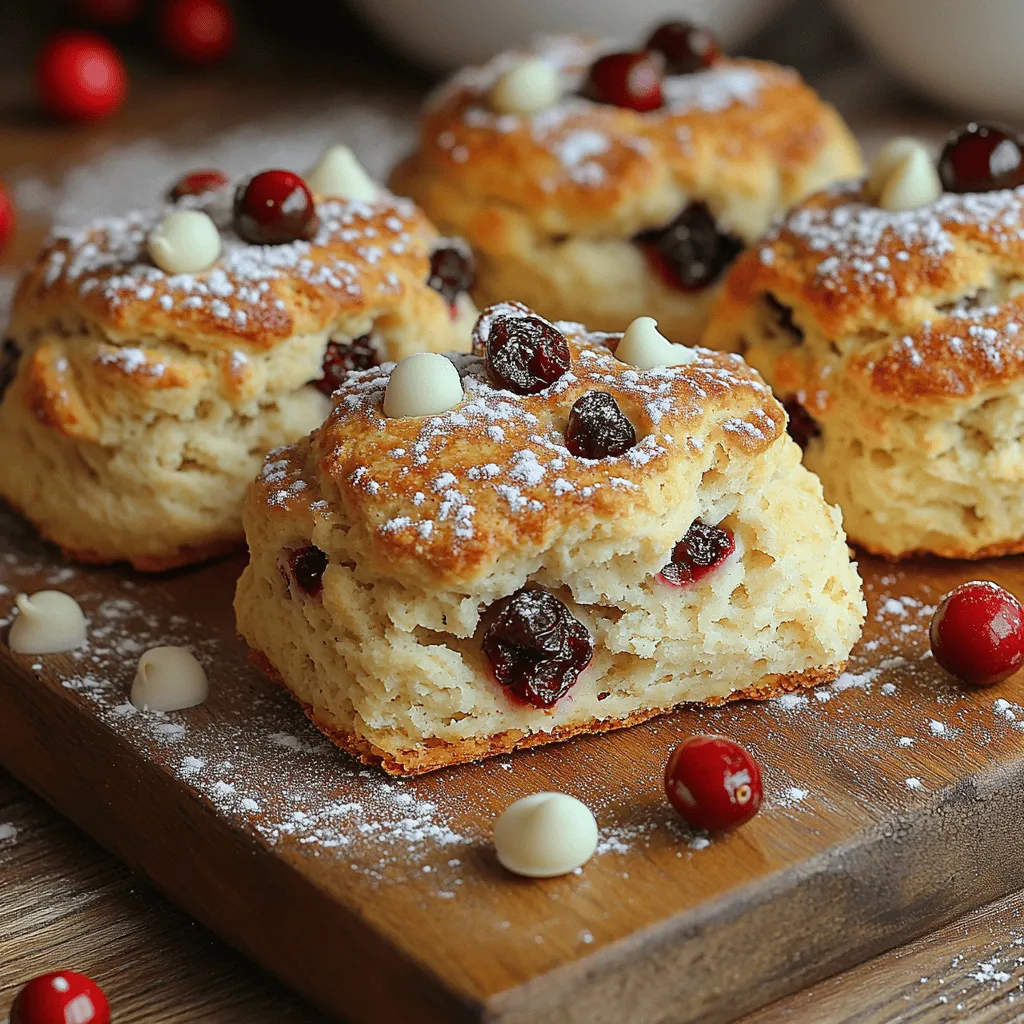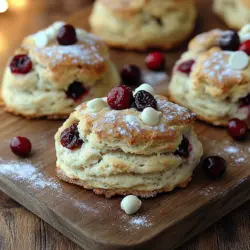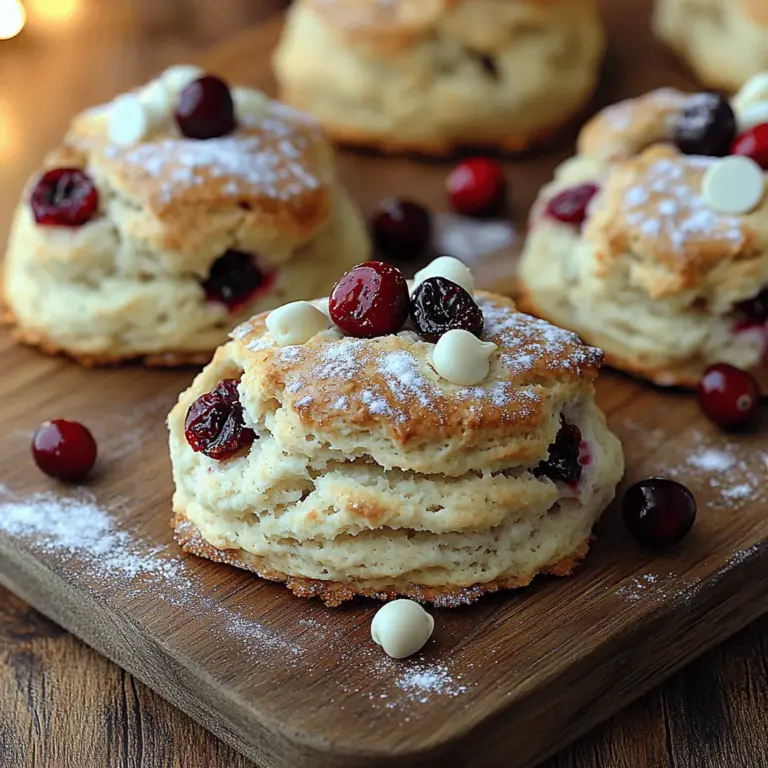Introduction
As the festive season approaches, kitchens around the world fill with the delightful scents of holiday baking. There’s something inherently joyful about this time of year; it invites us to gather with loved ones, share stories, and create lasting memories over delicious meals. Among the myriad of baked goods that grace our holiday tables, scones hold a special place—offering both versatility and a touch of elegance. Whether enjoyed during a leisurely brunch or served alongside afternoon tea, scones can elevate any gathering.
Today, we will dive into a recipe that perfectly embodies the spirit of the season: Festive Cranberry White Chocolate Scones. These delightful treats combine the tartness of cranberries with the sweetness of white chocolate, creating a harmonious blend that will tantalize your taste buds. Each bite of these scones delivers a satisfying crunch on the outside, while remaining soft and tender on the inside. With their vibrant colors and irresistible flavors, these scones are sure to become a cherished addition to your holiday baking repertoire.
Scones have a rich history and are traditionally associated with British tea time. Their popularity has transcended borders, becoming a beloved baked good in many cultures. They are often served during festive occasions, celebrations, and gatherings, making them a staple for holiday feasts. The combination of tart cranberries and sweet white chocolate not only makes for a delicious flavor profile but also adds a festive touch to your baking.
Throughout this article, we will explore the ingredients that contribute to the lusciousness of these scones, followed by a detailed step-by-step guide to help you craft the perfect batch.
Understanding the Ingredients
To create the best Festive Cranberry White Chocolate Scones, it’s essential to understand the role of each ingredient. By knowing how they interact, you can ensure a successful baking experience.
All-Purpose Flour: The Foundation of the Scone
All-purpose flour is the backbone of any scone recipe. It provides the necessary structure, ensuring that the scones rise properly while maintaining a tender crumb. When measuring flour, it’s crucial to avoid packing it into the measuring cup, as this can lead to dense scones. Instead, use the spoon-and-level method: spoon the flour into your measuring cup and then level it off with a knife for accuracy.
Granulated Sugar: Sweetness and Texture
Granulated sugar serves two primary purposes in our scone recipe. First, it adds sweetness to balance the tartness of the cranberries. Second, it contributes to the overall texture of the scone, helping to create a tender crumb. If you prefer a less sweet scone, you can reduce the amount of sugar slightly, but keep in mind that it may alter the final texture.
Baking Powder: The Leavening Agent
Baking powder is a key ingredient in scone-making, acting as the leavening agent that helps the scones rise. It releases carbon dioxide when it comes into contact with moisture and heat, creating air pockets that give the scones their light and fluffy texture. Always check the expiration date on your baking powder, as old powder may not provide the desired rise.
Salt: Enhancing Flavor
Though it may seem like a small component, salt plays a vital role in baking. It enhances the flavors of the other ingredients, bringing out their natural tastes. A pinch of salt in your scone mixture can make a significant difference, ensuring that each bite is balanced and flavorful.
Unsalted Butter: Richness and Flakiness
Unsalted butter is essential for achieving the rich, flaky texture that good scones are known for. The cold butter is cut into the flour, creating small pockets of fat that melt during baking, leading to a tender and flaky crumb. Using unsalted butter allows you to control the amount of salt in your scones, making it easier to achieve the perfect flavor balance.
Dried Cranberries vs. Fresh Cranberries: Flavor and Texture Considerations
Cranberries are the star of this recipe, adding a burst of tartness that beautifully complements the sweet white chocolate. You can opt for dried cranberries for convenience and ease of mixing, as they retain their shape during baking. If you prefer fresh cranberries, keep in mind that they are much more tart and can require adjustments to the sugar content in the recipe. Fresh cranberries will add a burst of juiciness but may also affect the scone’s texture.
White Chocolate Chips: Sweetness and Creaminess
White chocolate chips lend a creamy sweetness to the scones, creating a delightful contrast with the tart cranberries. When selecting white chocolate, look for high-quality products that contain cocoa butter, as this will ensure a smooth melting texture. Feel free to adjust the amount of white chocolate chips based on your preference for sweetness.
Heavy Cream, Egg, and Vanilla Extract: Binding and Flavor Enhancement
Heavy cream acts as the primary liquid in this scone recipe, providing moisture and richness. The egg contributes to the binding of the ingredients and adds additional richness to the scones. Lastly, a splash of vanilla extract enhances the overall flavor profile, making these scones even more irresistible.
Optional Additions: Extra Sugar for Sprinkling
For a touch of sweetness and a delightful crunch, consider sprinkling a bit of extra sugar on top of the scones before baking. This simple addition can create a beautiful golden crust and elevate the overall presentation of your festive scones.
Step-by-Step Guide to Making Festive Cranberry White Chocolate Scones
Now that we have explored the essential ingredients, let’s dive into the process of making these delicious scones. Follow this step-by-step guide to ensure your baking success.
Prepping the Kitchen: Essential Tools and Equipment
Before you begin, gather all the necessary tools and equipment. Having everything prepared will make the baking process smoother and more enjoyable. Here’s what you’ll need:
– Baking Sheet: A sturdy baking sheet will provide a solid base for your scones.
– Parchment Paper: Lining your baking sheet with parchment paper prevents sticking and makes for easy cleanup.
– Mixing Bowls: You’ll need a large mixing bowl for combining dry ingredients and a smaller bowl for wet ingredients.
– Pastry Cutter or Fork: These tools are essential for cutting in the butter into the flour mixture.
– Measuring Cups and Spoons: Accurate measurements are crucial for successful baking.
– Whisk: A whisk is ideal for mixing dry ingredients and incorporating the egg into the wet mixture.
Preheating the Oven: Importance of Temperature in Baking
Before you start mixing your ingredients, preheat your oven to 400°F (200°C). Preheating is essential in baking, as it ensures that your scones will rise properly and develop a lovely golden crust. A hot oven will allow the baking powder to activate immediately, leading to light and fluffy scones.
Mixing the Dry Ingredients: Techniques for Thorough Blending
In your large mixing bowl, combine the all-purpose flour, granulated sugar, baking powder, and salt. Whisk the dry ingredients together until they are evenly blended. This step is crucial, as it ensures that the leavening agent is distributed evenly throughout the flour, helping your scones rise uniformly.
Incorporating the Butter: Best Practices for Achieving the Right Crumb Texture
Next, it’s time to cut in the cold, unsalted butter. Cut the butter into small cubes and add it to the flour mixture. Using a pastry cutter or fork, work the butter into the flour until the mixture resembles coarse crumbs. The goal is to create small flecks of butter throughout the flour, which will melt during baking and create the desired flaky texture. Be careful not to overwork the dough; you want to retain some of the butter’s shape for optimal flakiness.
Once the butter is incorporated, it’s time to add the cranberries and white chocolate chips to the dry mixture. Gently fold them in with a spatula or wooden spoon, ensuring they are evenly distributed throughout the dough.
Stay tuned for the next part, where we will continue with the exciting steps of bringing these festive scones to life, including the addition of wet ingredients, shaping the dough, and the baking process.

Adding Mix-ins: Tips for Even Distribution of Cranberries and White Chocolate
To achieve a harmonious blend of flavors in your Festive Cranberry White Chocolate Scones, it’s crucial to evenly distribute the mix-ins throughout the dough. Begin by measuring out your dried cranberries and white chocolate chunks, ensuring they are roughly the same size for consistent melting and texture. To prevent the cranberries from clumping together, consider tossing them in a small amount of flour before adding them to the dough. This light coating will help them to be evenly distributed and minimize their tendency to sink to the bottom during baking.
When you incorporate the cranberries and white chocolate into the dough, do so gently. Use a spatula or wooden spoon and fold the ingredients in slowly to avoid breaking the chocolate chunks and cranberries. Aim for an even distribution without overworking the dough, as this will help maintain the light, flaky texture of the scones.
Combining Wet and Dry Ingredients: Avoiding Overmixing for Perfect Texture
The key to achieving the perfect texture in your scones lies in how you combine the wet and dry ingredients. Start by whisking together your dry ingredients—flour, sugar, baking powder, and salt—in a large bowl. In a separate bowl, mix your wet ingredients, including buttermilk and melted butter. Once you have both mixtures ready, create a well in the center of the dry ingredients and pour in the wet mixture.
Using a fork or spatula, gently stir the mixture until just combined. It’s essential to mix only until the flour is no longer visible; overmixing will lead to dense, tough scones instead of the desired light and fluffy texture. You should still see a few small lumps in the dough.
Shaping the Dough: Techniques for Forming and Cutting Scones
Once your dough is mixed, it’s time to shape it into scones. Turn the dough out onto a lightly floured surface and gently pat it into a square or circle, about 1-inch thick. The thickness is important, as it affects the final size and texture of the scones.
To cut the scones, you can either use a sharp knife to slice the dough into wedges or use a round biscuit cutter for circular scones. If you opt for wedges, simply cut the dough into triangles, making sure to press down firmly without twisting the knife. If using a biscuit cutter, dip it in flour to prevent sticking and press down firmly into the dough.
Brushing and Sprinkling: Enhancing Appearance and Taste
Before baking, give your scones a lovely finish by brushing the tops with a bit of heavy cream or milk. This step not only adds shine but also helps to create a beautiful golden-brown crust. For an extra touch of festive flavor and texture, sprinkle a light layer of coarse sugar on top after brushing. The sugar will caramelize during baking, providing a delightful crunch with each bite.
Baking the Scones: Ideal Time and Temperature for Optimal Results
Preheat your oven to 400°F (200°C) to ensure your scones rise beautifully. Arrange the shaped scones on a baking sheet lined with parchment paper, ensuring they are spaced apart to allow for expansion. Bake in the preheated oven for approximately 15-20 minutes or until the tops are golden and a toothpick inserted into the center comes out clean.
Keep an eye on the scones during the last few minutes of baking, as oven temperatures can vary. You want them to be golden brown and firm to the touch but still soft inside. If the tops are browning too quickly, you can cover them loosely with aluminum foil to prevent burning while the insides finish baking.
Cooling and Serving: Best Practices for Enjoying Scones Fresh
Once baked, remove the scones from the oven and allow them to cool on the baking sheet for about 5 minutes. This resting time helps them to set and makes them easier to transfer to a wire rack. Afterward, move the scones to the rack to cool completely.
Scones are best enjoyed fresh but can also be served warm. If you prefer them warm, simply reheat them in the oven for a few minutes at a low temperature. For an indulgent treat, consider serving the scones with clotted cream, butter, or a drizzle of white chocolate glaze.
Baking Tips for Perfect Scones
To ensure your Festive Cranberry White Chocolate Scones turn out perfectly every time, consider the following tips:
– Common Pitfalls to Avoid: Overmixing is a common mistake that leads to tough scones. Mix just until combined. Also, avoid using cold ingredients straight from the fridge; they should be at room temperature for the best results.
– Adjusting Texture: If your scones are too dense, consider adding a bit more baking powder to the dry ingredients. On the other hand, if they are too crumbly, try adding a touch more buttermilk until the desired consistency is achieved.
– Flavor Variations: Don’t hesitate to experiment with flavors. You can substitute the cranberries with dried cherries or raisins, and swap the white chocolate for dark chocolate or even a mix of both. Adding spices like cinnamon or nutmeg can also enhance the flavor profile.
– Storage Tips: To keep your scones fresh, store them in an airtight container at room temperature for up to two days. For longer storage, freeze the unbaked dough and bake them fresh when needed. This way, you can enjoy warm scones anytime.
Serving Suggestions and Pairings
Festive Cranberry White Chocolate Scones make an excellent addition to any holiday gathering or cozy afternoon tea. Here are some serving suggestions:
– Ideal Accompaniments: Pair your scones with a warm cup of tea or coffee. A dollop of clotted cream or a spread of jam (such as raspberry or orange marmalade) complements the sweetness of the scones beautifully.
– Creative Serving Ideas: Consider serving the scones on a tiered platter for a beautiful presentation at holiday brunches. You can also create a scone bar with various spreads and toppings to encourage guests to customize their own treats.
– Presentation Tips: To create a festive table setting, use seasonal decorations like holly or pinecones. A simple white tablecloth adorned with red and green accents can elevate the overall dining experience.
Nutritional Analysis of Festive Cranberry White Chocolate Scones
Understanding the nutritional content of your scones can help in making informed choices, especially during the indulgent holiday season. Each scone contains approximately 240 calories, with 10g of fat, 35g of carbohydrates, and 3g of protein. The inclusion of cranberries provides beneficial antioxidants and fiber, while the white chocolate adds a touch of sweetness.
For those seeking healthier alternatives, consider using whole wheat flour in place of all-purpose flour for added fiber. You can also reduce the amount of sugar or use natural sweeteners like honey or maple syrup. Additionally, using low-fat milk instead of heavy cream can lower the overall calorie count.
Conclusion
Baking and sharing Festive Cranberry White Chocolate Scones is not just about creating a delicious treat; it’s about embracing the joy of the holiday season. These scones, with their delightful combination of tart cranberries and sweet white chocolate, bring warmth and cheer to any gathering. As you whip up this delightful recipe, remember that the kitchen is a place for creativity and connection.
Encourage family and friends to join in the baking process, creating memories that will last long after the last crumb is enjoyed. Homemade treats have a unique way of bringing people together, spreading joy, and celebrating the spirit of the season. So gather your ingredients, preheat your oven, and let the delightful aroma of freshly baked scones fill your home, reminding you of the magic of the holidays.

